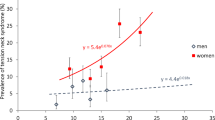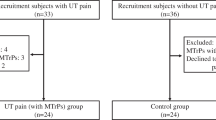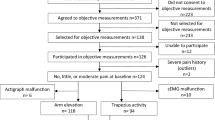Abstract
A case-control study with matched pairs was initiated to investigate the relationship between shoulder-neck complaints and activity in the upper trapezius muscle. The matching was done so that the physical demands from work (external exposure) were equal for both the case and the control. Each pair was also matched for gender, age, working hours, and employment time. Male (n = 18) and female workers (n = 78) employed in both manual and office work were included. Muscle activation levels and pause patterns during work and muscle activity during tests of attention, coordination, and rest were recorded by surface electromyography. The results showed consistent associations between pain and signs of increased activation of the upper trapezius for the cases in the manual group. No such associations were observed in the office group. The results are consistent with the hypothesis that muscle activation patterns may in some instances, but not in all, explain why some workers develop pain while others do not in work situations where the physical demands are similar.
Similar content being viewed by others
References
Aarås A, Stranden E (1988) Measurement of postural angles during work. Ergonomics 31:935–944
Altman DG (1991) Practical statistics for medical research. Chapman and Hall, London
Altman DG, Bland JM (1983) Measurement in medicine: the analysis of method comparison studies. Statistician 32:307–317
Bland JM, Altman DG (1986) Statistical methods for assessing agreement between two methods of clinical measurements. Lancet 1:307–310
Edwards RHT (1988) Hypotheses of peripheral and central mechanisms underlying occupational muscle pain and injury. Eur J Appl Physiol 57:275–281
Elert JE, Rantapää-Dahlgvist SB, Henriksson-Larsèn K, Lorentzon R, Gerdle BUC (1992) Muscle performance, electromyography and fibre type composition in fibromyalgia and work-related myalgia. Scand J Rheumatol 21:28–34
Erdelyi A, Sihvonen T, Helin P, Hänninen O (1988) Shoulder strain in keyboard workers and its alleviation by arm support. Int Arch Occup Environ Health 60:119–124
Hägg GM, Suurküla J, Kilbom Å Predictors for work related shoulder/neck disorders. A longitudinal study of female assembly workers. Arbete och Hälsa 10:1–78
Hand DJ (1981) Discrimination and classificatin. Wiley, New York
Jensen C, Nilsen K, Hansen K, Westgaard RH (1993a) Trapezius muscle load as a riskndicator for occupational shoulder-neck complaints. Int Arch Occup Environ Health 64:415–423
Jensen C, Vasseljen O Jr, Westgaard RH (1993b) The influence of electrode position on bipolar surface EMG recordings of the upper trapezius muscle. Eur J Appl Physiol 67:266–273
Jonsson B (1978) Kinesiology-with special reference to electromyographic kinesiology. Contemp Clin Neurophysiol 34:417–428
Saunders D (1985) Evaluation, treatment and prevention of musculoskeletal disorders. Viking, Minneapolis
Takala EP, Viikari-Juntura E (1991a) Muscular activity in simulated light work among subjects with frequent neck-shoulder pain. Int J Ind Erg 8:157–164
Takala EP, Viikari-Juntura E (1991b) Loading of shoulder muscles in a simulated work cycle: comparison between sedentary workers with and without neck-shoulder symptoms. Clin Biomech 6:145–152
Travell JG, Simons DG (1983) Myofascial pain and dysfunction. The trigger point manual. Williams & Wilkins, Baltimore
Vasseljen O Jr, Westgaard RH, Larsen S (1994) A case-control study of psychological and psychosocial risk factors for shoulder and neck pain at the work place. Int Arch Occup Environ Health 66:375–382
Veiersted KB (1993) Sustained muscle tension as a risk factor for trapezius myalgia. In: Nielsen R, Jorgensen K (eds) Advances in industrial ergonomics and safety V. Taylor and Francis, London, pp 15–19
Veiersted KB, Westgaard RH (1993) Development of trapezius myalgia among female workers performing light manual work. Scand J Work Environ Health 19:277–283
Veiersted KB, Westgaard RH, Andersen P (1990) Patterns of muscle activity during stereotyped work and its relation to muscle pain. Int Arch Occup Environ Health 62:31–41
Veiersted KB, Westgaard RH, Andersen P (1993) Electromyographic evaluation of muscular work pattern as a predictor of trapezius myalgia. Scand J Work Environ Health 19:284–290
Wærsted M, Westgaard RH (1991) Working hours as a risk factor in the development of musculoskeletal complaints. Ergonomics 34:265–276
Wærsted M, Eken T, Westgaard RH (1993) Psychogenic motor unit activity: a possible muscle injury mechanism studied in a healthy subject. In: Jacobsen S, Danneskiold-Samsoe B, Lund B (eds) Musculoskeletal pain, myofascial pain syndrome, and the fibromyalgia syndrome. Haworth, New York, pp 185–190
Wærsted M, Bjørklund R, Westgaard RH (1994) The effect of motivation on shoulder-muscle tension in attention-demanding tasks. Ergonomics 37:363–376
Westgaard RH, Bjørklund R (1987) Generation of muscle tension additional to postural muscle load. Ergonomics 30:911–923
Westgaard RH, Jansen T (1992) Invididual and work related factors associated with symptoms of musculoskeletal complaints. I. A quantitative registration system. Br J Ind Med 49:147–153
Westgaard RH, Jensen C, Nilsen K (1993) Muscle coordination and choice-reaction time tests as indicators of occupational muscle load and shoulder-neck complaints. Eur J Appl Physiol 67:106–114
Winkel J, Westgaard RH (1992) Occupational and individual risk factors for shoulder-neck complaints. Part II. The scientific basis (literature review) for the guide. Int J Ind Erg 10:85–104
Author information
Authors and Affiliations
Rights and permissions
About this article
Cite this article
Vasseljen, O., Westgaard, R.H. A case-control study of trapezius muscle activity in office and manual workers with shoulder and neck pain and symptom-free controls. Int. Arch Occup Environ Heath 67, 11–18 (1995). https://doi.org/10.1007/BF00383127
Received:
Accepted:
Issue Date:
DOI: https://doi.org/10.1007/BF00383127




